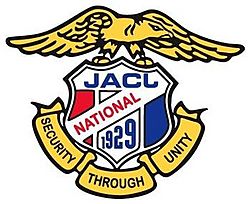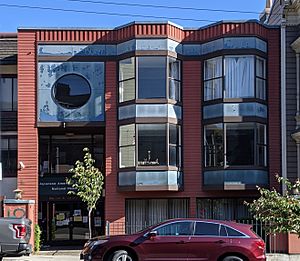Japanese American Citizens League facts for kids
 |
|

JACL's San Francisco headquarters in 2021
|
|
| Founded | 1929 |
|---|---|
| Type | 501(c)(3) charitable organization |
| Focus | Asian American civil rights |
| Headquarters | San Francisco, United States |
| Location |
|
The Japanese American Citizens League (日系アメリカ人市民同盟, Nikkei Amerikajin Shimin Dōmei) is a group that works for civil rights for Asian American people. It is based in San Francisco, USA. The JACL has many local groups all over the United States.
The JACL says it is the oldest and largest Asian American civil rights group in the country. It focuses on making sure all Americans have fair and equal rights. This is especially true for the Asian Pacific American community. The organization started in 1929. It was formed from other groups for Nisei (second-generation Japanese Americans) in California and Washington.
In its early years, the JACL worked to change laws. These changes would give Japanese Americans more citizenship rights. Local groups also held meetings to help Nisei get more involved in politics. During World War II, the JACL faced criticism. Some people felt it did not do enough to stop the imprisonment of Japanese Americans. It also helped U.S. intelligence groups find "disloyal" Issei (first-generation Japanese immigrants). The JACL also took a strong stand against those who refused to join the army from the camps. These issues still cause disagreements within the Japanese American community and the JACL itself.
After the war, the JACL focused again on civil rights laws. It worked with Congress and filed lawsuits. These actions aimed to change or get rid of laws about marriage between different races, separation by race, and race-based limits on immigration. In the 1970s, the JACL joined the movement to get fairness and payment for the wartime imprisonment. The JACL's efforts were very important. They helped pass the Civil Liberties Act of 1988. This law officially said the imprisonment was wrong. It also provided payments to those who were affected. Later, in 2002, younger JACL leaders apologized. They said sorry for their past actions against Nisei who refused to join the army.
Today, the JACL has over 100 local groups. Most are in big cities across the U.S. These groups are part of seven larger district councils. Each council has a leader. The whole organization is led by a board of elected officials.
Contents
The JACL's Story
How the JACL Started (1929–1941)
In 1929, several Nisei groups joined together. They formed the Japanese American Citizens League (JACL). Important groups included the American Loyalty League (アメリカ忠誠協会, Amerika Chūsei Kyōkai) from Fresno. This group was led by Dr. Thomas T. Yatabe, a Nisei dentist. Another was the Seattle Progressive Citizens League (シアトル革新市民連盟, Siatoru Kakushin Shimin Renmei). The San Francisco-based New American Citizens League (新アメリカ市民協会, Shin Amerika Shimin Kyōkai) was also key. It was led by Nisei lawyer Saburo Kido.
The JACL wanted to help Nisei professionals and small business owners. It aimed to support free business, self-reliance, and loyalty to the United States. Because of this, the group did not use a hyphen in its name.
The first national JACL meeting was held in Seattle in 1930. This was thanks to James Sakamoto and other Seattle activists. Soon after, the JACL began working to expand rights for Japanese and other Asian Americans. At that time, many Asian immigrants could not become U.S. citizens. The JACL first targeted the Cable Act of 1922. This law took away citizenship from women who married men who could not become citizens. After the JACL worked hard, Congress changed the law in 1931.
Next, the JACL started a campaign. It wanted to allow Issei and other Asian American veterans of World War I to become U.S. citizens. In 1935, the Nye-Lea Act passed. This law gave these men citizenship rights.
The JACL started with ten groups in 1930. By 1935, it had 42 groups. Most were on the West Coast. By 1940, there were 53 groups. Some were in Idaho, Utah, Colorado, and Arizona.
Japanese American Imprisonment During World War II (1941–1945)
In 1941, the Imperial Japanese Navy attacked Pearl Harbor. Within hours, the Federal Bureau of Investigation (FBI) began arresting Japanese American community leaders. These were mostly Issei teachers, priests, and business owners. JACL members spoke at government hearings. They wanted to show that Nisei were loyal Americans. This was to fight rumors that had spread after Pearl Harbor. At the same time, the JACL helped the FBI find Issei who might be disloyal. Many Japanese Americans felt this action tried to protect some people at the cost of others.
When President Franklin D. Roosevelt signed Executive Order 9066, JACL leaders did not challenge it. This order forced Japanese Americans to leave the West Coast. The JACL believed it was better to follow government orders. They told the nearly 120,000 affected people to go peacefully. They also kept their distance from those who fought the order. After the war, lawyer Wayne M. Collins criticized the JACL. He said they "wouldn't stand up for their people."
During the war, the JACL tried to help Japanese Americans. They offered loans and opened offices in Chicago. These offices helped families move to the Midwest. The organization also argued that Japanese Americans should be allowed to serve in the U.S. military. In Hawaii, many leaders supported Japanese men joining the military. This led to the creation of the 100th Infantry Battalion and the 442nd Regiment Combat Team.
Working for Fairness After the War (1945–1988)
After the war, the JACL began to rebuild. In 1945, only 23 groups were left. By 1950, many old groups had started again. The total reached 80. These groups were still mostly in the West. But important groups also existed in big cities in the Midwest and East Coast.
In the late 1940s, the JACL started working on new laws for Japanese Americans. The JACL worked to get rid of California's Alien Land Law. This law stopped Japanese immigrants from buying land. In 1948, the JACL helped pass the Evacuation Claims Act. This was the first step to fix the wrongs of the wartime imprisonment. In 1949, the JACL began efforts in Congress. They wanted Japanese immigrants to be able to become naturalized citizens of the U.S.
In 1970, the JACL supported a plan by member Edison Uno. This plan asked Congress to pay each camp survivor for every day they were held. Later, in 1979, the JACL suggested creating a federal group. This group would look into the imprisonment. The next year, the JACL worked with Senators Daniel Inouye and Spark Matsunaga. They helped pass a bill to create the Commission on Wartime Relocation and Internment of Civilians (CWRIC). In 1983, the CWRIC shared its findings. It suggested an official government apology and payments to survivors. This happened with the passage of the Civil Liberties Act of 1988. President Ronald Reagan signed it into law.
JACL Today: After Redress (1988–Present)
In 1994, the JACL held its national meeting. There, it passed a resolution. This statement supported the basic human right to marry, including for same-sex couples. In 2012, the JACL was the first national civil rights group to openly support this. It also praised President Barack Obama for his support of same-sex marriage.
Since 2022, the JACL has supported the idea of reparations for slavery. It has backed local plans for reparations. The JACL has also asked the Biden administration to start studying federal reparations for African Americans. JACL representatives have spoken in favor of creating the Philadelphia Reparations Task Force.
JACL Programs and Activities
Bridging Communities Program
The Bridging Communities Program brings young people together. It connects youth from Japanese and Asian American communities with Muslim and Arab American youth. High school students attend workshops. They learn about identity, community, organizing, culture, and feeling strong. The program includes visits to the Tule Lake Relocation Center, Manzanar, and Minidoka National Historic Site camps. These places held Japanese Americans during World War II. The National Park Service helps fund this program.
Other groups that work with the JACL on this program include the Council on American-Islamic Relations and the Tule Lake Pilgrimage Committee.
JACL/OCA Leadership Summit
This is a three-day yearly training event for leaders. It is a joint program by the JACL and OCA National (formerly the Organization of Chinese Americans). Workshops cover topics like how to build strong groups and how to lobby successfully.
Youth Leadership Summit
The JACL's Youth Leadership Summit started in 2010. It has been held every year in cities like Chicago, Portland, and Washington DC.
Scholarships for Students
The JACL started its National Scholarship and Awards Program in 1946. It offers scholarships to students at different stages of their education. These include new college students, undergraduates, and graduate students. There are also scholarships for those with financial need and for creative arts. All scholarships are one-time awards.
The League of Dreams Documentary
JACL National and film producer Lane Nishikawa are working together. They are creating a documentary about the JACL's 90-year history. Nishikawa wants the film to show the story of the JACL. This is the oldest and largest Asian American civil rights group in the U.S. The project has received grants from different organizations.
Anti-Hate Program
The JACL created its Anti-Hate Program. This was in response to more hate crimes against Asian Americans after COVID-19. The JACL aims to stop the use of bad stereotypes about Asian Americans and Pacific Islanders. To do this, the JACL watches and fights hate crimes. This includes unfair treatment and racial profiling. The program lists resources to help with anti-Asian hate.
JACL National Conventions
History of National Conventions
The first JACL National Convention was held on August 29, 1930, in Seattle, Washington. The first convention after World War II was in Denver, Colorado. At that meeting, they agreed on a 14-point plan for rebuilding. This plan included rights for Issei to become citizens. It also called for fairness for unfair treatment during the war. Other goals included ending racial discrimination in housing and jobs.
1970 National Convention
The 1970 JACL convention was a time when the JACL showed its strong commitment to racial justice for all Americans.
2013 National Convention
The 2013 JACL National Convention took place from July 24–26, 2013. It was held in Washington, DC. The theme for this 44th convention was "Justice for All."
JACL Locations: Headquarters, Districts, and Chapters
As of 2025, the JACL's main office is in San Francisco's Japantown neighborhood. It is right next to the Japanese American Association of Northern California. This group says it is the oldest Japanese American Community organization, started in 1895.
The JACL also has an office in Washington DC. It has over 100 local groups across the U.S. These groups are organized into seven district councils:
- Central California District Council
- Eastern District Council
- Intermountain District Council
- Midwest District Council
- Northern California-Western Nevada-Pacific District Council
- Pacific Northern District Council
- Pacific Southwest District Council
The JACL did not have a group in Hawaii before or after World War II. A group was finally started there in 1980.
Well-Known JACL Members
- Frank Chuman
- Gordon Hirabayashi
- Mike Honda
- Chris Iijima
- Saburo Kido
- Mike Masaoka
- Doris Matsui
- Robert Matsui
- Spark Matsunaga
- Stan Matsunaka
- Norman Mineta
- James Y. Sakamoto
- Charles Z. Smith
- Ina Sugihara
- George Takei
- Grayce Uyehara
- George Yuzawa
See Also
- Pacific Citizen
- Japanese Americans
- Densho: The Japanese American Legacy Project
- Japanese American Committee for Democracy
- Japanese American National Library
- Japanese American National Museum
- Japan–United States relations
- Anti-Japanese sentiment in the United States
- Consulate-General of Japan, San Francisco
- U.S.-Japan Council

